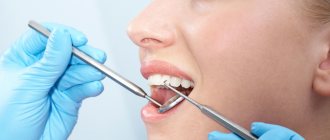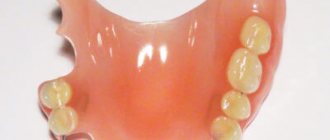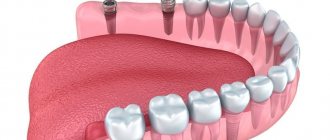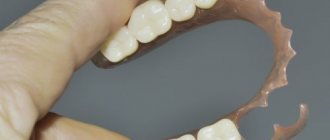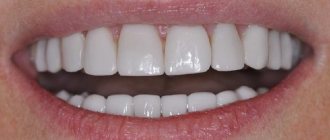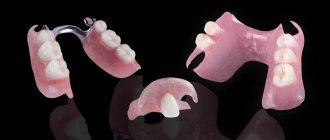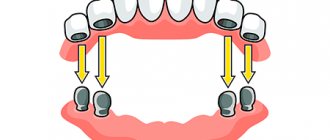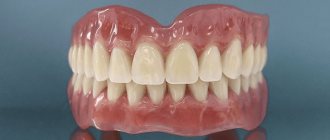Materials Manufacturing of removable dentures Manufacturing of fixed dentures Service life
The absence of teeth affects not only the function of chewing and speech, but also the emotional state, socialization and self-esteem. Prosthetics restores physiological functions, equalizes the emotional background, and increases self-confidence.
Making dentures is the result of a joint effort between a dentist and a technician. Each stage of work affects the final result. The manufacturing process depends on the type of structure and materials used.
There are the following types of restorations for restoring the dentition:
- Removable
. They are divided into full and partial. Full ones are used for edentia, when there are no teeth left at all. Partially removable ones are attached to the remaining teeth, which serve as support. - Fixed
. Unlike removable structures, inlays, crowns and bridges are fixed in the mouth for the entire period of use. They are removed only to replace them with new ones. - Conditionally removable
. Such dentures can be removed, but under certain conditions. The removable jaw is fixed on implants. You will not be able to remove the restoration yourself. The dentist will do this without difficulty, and after the necessary procedures, he will put it back.
Materials for the manufacture of prostheses
For permanent restorations, metals, ceramics and zirconium dioxide are used. Metal-ceramic crowns consist of 2 layers: a metal base, which is lined with a ceramic composition. Thick double walls require strong turning. Zirconium crowns are very durable, so the teeth need to be prepared minimally for them. New ceramic compositions, such as E-max, are quite durable and at the same time make it possible to choose the color of teeth of any shade.
The same materials can be used for conditionally removable prosthetics.
For removable dentures, the most important element is the base. The base is made from:
- Acrylic
- Acry Free
- Nylon
The hardest material is acrylic. Its disadvantages are microporosity and rapid wear. Acrylic contains substances that cause allergies. Pros: low cost and ease of processing.
Acry Free is a material that contains no allergens, it is softer and thinner than acrylic. It is easier to get used to such a product.
Nylon restorations fit comfortably in the mouth and do not cause allergies, but do not distribute the chewing load well enough due to their softness.
Metals and plastics are used for fastening elements of partial removable structures. And for the base - the same acrylic and plastics based on acrylic resins.
The service life of acrylic restorations is about 3 years, Acry Free and nylon restorations are 5 years. Dentures are replaced for several reasons. This could be a breakdown, an allergy, or a desire to replace an old design with a more modern one. The main thing is that removable structures do not stop bone loss. The relief of the oral cavity changes, the gums sag, and the restoration no longer fits.
Types of removable prosthetics
Complete - prosthetics in the absence of teeth.
Partial is a way to restore chewing efficiency after the loss of one or more teeth.
Conditionally removable - temporary structures that are fixed using claws, clasps and special cements with the ability to be removed by a doctor in the dental office.
Immediate prosthetics are temporary removable structures.
The main types of such prostheses:
Plate prostheses
Plate:
- Partial and complete;
- Acrylic and nylon .
Clasp:
- With clasp fastening;
- With lock fastening.
- On telescopic crowns.
Manufacturing of removable dentures
The process of manufacturing restorations is called clinical-laboratory because it is carried out in close cooperation between the clinic and the laboratory. There are 4 clinical stages in the technology of removable dentures. Between them they carry out work in the laboratory.
First clinical stage
It is performed by an orthopedic dentist. Work begins with collecting anamnesis. The doctor collects information about health status, allergic reactions, and working conditions.
Then the dentist carries out:
- General examination
of the patient. The orthopedist pays attention to the bite, the structure of the jaws, and the condition of the prosthetic bed. The level of preservation of the remaining teeth, if any, is determined. - Special examination
. This includes motor and speech tests, registration of chewing and swallowing characteristics. An X-ray examination is performed and a tomography is performed. - Drawing up a treatment plan
. At this stage, the type of restoration and material for production are determined. - Taking impressions
. Using an orthopedic spoon, the doctor makes anatomical casts of the jaws. In simple cases, this is enough. For complex defects, individual spoons are made. The impressions are sent to the laboratory, where a technician gets to work.
Based on the plaster models, the technician makes an individual spoon. To do this, he uses plastics, thermoplastics or wax. After finishing the work, he hands the spoon to the doctor.
A custom tray is used by the orthopedist to obtain a functional impression. This method is used when:
- severe atrophy of bone tissue;
- some anatomical features (folds on the palatine bed, for example);
- with single-standing teeth, in the case of partial structures.
Second clinical stage
Determination of central occlusion (places of contact when closing the jaws).
Denture manufacturing techniques include casting plaster models and casting wax bases with occlusal ridges. Using them, the doctor determines the central relationship of the jaws. To do this, a wax model is placed in the mouth and height measurements are taken. The orthopedist places marks on the rollers to secure the teeth. At this stage, the color for future crowns is selected.
In the laboratory, the technician places the model in the occluder, selects the size, color and shape of the artificial teeth in accordance with the recommendations of the orthopedist and distributes them into the jaw. He then checks all structural elements.
When making clasp restorations, at this stage the frame is cast. It is ground and polished.
Third clinical stage
Fitting. The goal is to eliminate errors, check aesthetics and conduct speech tests. The doctor makes the adjustment himself; to eliminate complex errors, the product is sent to the laboratory.
After adjustment, installation is carried out. The moment the patient receives the restoration is considered the final clinical stage of the work.
The production of dentures in the clinic’s own laboratory helps the orthopedist and the technician to interact on an ongoing basis and clarify certain issues during the production of the restoration. In addition, working directly in the clinic, the technician is more interested in how the denture is made; the reputation of the clinic depends on his qualifications. This increases responsibility, which affects the quality of structures and ease of use.
Complete prosthetic structures
If all teeth in one or both jaws are lost, impaired chewing and aesthetic functions can be restored using a complete removable denture. It is used if it is not possible to solve the problem with prosthetics on implants. This design has an arc shape and externally represents an even row of teeth fixed in a base that imitates gums.
Fixation Features
The maxillary systems are held on the palate by a suction effect. After the patient puts on the artificial teeth and bites on them, excess air comes out from under the base and bridge, and the structure is tightly suctioned to the palate and gums. It is difficult to achieve a good fit on the lower jaw. Therefore, special creams with adhesive properties can be used for additional fixation.
Manufacturing materials
Complete removable systems can be made from conventional acrylic plastic, polyurethane or monomer-free thermoplastics. The cost, reliability and effectiveness of the orthopedic design depend on the type of material.
Fixed dentures
Fixed restorations include inlays, veneers, crowns and bridges. The manufacturing scheme differs only in small details. For example, let's take the manufacture of a bridge structure.
Preparation for the manufacture of a fixed denture begins with collecting anamnesis, making a diagnosis and preparing the teeth. The first clinical stage ends with the taking of impressions.
First laboratory stage
The impression technician makes a plaster cast and wax base with occlusal ridges. The model is then handed over to the doctor to determine the central occlusion. After this, the model goes back to the technician.
Second laboratory stage
The technician places the model in an articulator (a dental apparatus that simulates the closure of the jaws) and prepares models of ground teeth. Models crowns on abutment teeth and artificial teeth between them. Depending on how the denture is made, the technician makes metal crowns by casting, ceramic ones by pressing, and grinds zirconium crowns on a milling machine. The bridge is transferred to the orthopedist.
The dentist tries on the crowns and adjusts them. Notes any imperfections and sends them to the technician for final processing.
Third laboratory stage
The structure is polished and ground. In the case of metal ceramics, the metal base is processed and a ceramic coating is applied to it. The finished bridge is sent to the orthopedist, who fixes it on the patient’s teeth.
The production of dentures for the upper jaw follows the same protocol as for the lower jaw.
Clasp dentures with locking fastening
Characteristic
Attachments (locks) are a more rigid and completely invisible type of fastening. All supporting parts are located on the side of the oral cavity. When using removable dentures with locking fasteners, it is necessary to carry out periodic monitoring, adjustment, and, if indicated, replacement of attachment components.
Indications
Included and terminal defects of the dentition. Violation of aesthetics, chewing and speech. Treatment of high levels of tooth wear. Using a prosthesis as a splint during periodontal treatment . Atrophy of the alveolar process, in which the use of plate prostheses is not allowed. Flat palate, pronounced maxillary tuberosities. For dividing extended fixed structures into separate parts to prevent chipping of the ceramic veneering of crowns. For prosthetics on implants.
Contraindications
Periodontal atrophy of supporting teeth more than 1/3 of the root length. Low clinical crown of the abutment tooth (less than 5 mm). The inability of patients to come for follow-up examinations once every six months should be considered as a contraindication to the use of locking fasteners. Poor oral hygiene (attachments can contribute to the formation of hard plaque, which limits the effectiveness of the clasp). Limited manual skills of the patient (arthritis; Parkinson's disease; diseases that can impair motor function).
Clasp dental prosthetics
Today, clasp dentures are spoken of as one of the most reliable, comfortable and cost-effective ways to restore the functions of lost teeth. Translated from German, bugel means “arc”. A clasp denture is a partially removable orthopedic structure that evenly distributes the load between the remaining teeth and the surface of the jaw. The clasp product consists of a cast metal frame carrying a base made of detailed plastic with artificial dental units. The frame made of titanium or cobalt chromium alloy, along with all fastening elements, is manufactured in the laboratory according to the patient’s individual measurements.
Methods of fixing clasp dentures:
- clasp (using support-retaining clasps of various types);
- locking (using locks-attachments);
- telescopic systems (structures consisting of an internal metal cap and an external crown, precisely adjusted to the recesses and reproducing the shape of the tooth).
Clasp dentures are used to restore one or more lost teeth in the presence of end or lateral defects, and are also used as a method of fixation in the treatment of periodontal disease. They are installed only if there are supporting dental units.
Advantages. Clasp designs have high aesthetic qualities, do not require removal during meals or before bed, do not affect taste and temperature sensations, are lightweight and easy to care for.
Flaws. The disadvantages of clasp dental prosthetics include a fairly long period of adaptation and the need to correct the position of the hooks.
Prices for clasp prosthetics
| Clasp denture (from 3 clasps) | 38,000 rub. |
| Simple clasp prosthesis | 30,000 rub. |
| Clasp prosthesis made of acetal | 32,000 rub. |
| Splinting clasp prosthesis made of acetal | 36,000 rub. |
| Splinting clasp prosthesis with imported teeth | 38,000 rub. |
| One-sided clasp prosthesis with MK-1 lock | 42,000 rub. |
| Clasp prosthesis with two locks MK-1 | 58,000 rub. |
| Single-sided clasp prosthesis with Bredent lock | 40,000 rub. |
| Clasp prosthesis with two Bredent locks | 62,000 rub. |
| Clasp prosthesis on telescopic crowns | 48,000 rub. |
| Clasp denture in combination with Flexy-Nylon | 35,000 rub. |
| Clasp prosthesis using attachments on a titanium frame | 32,000 rub. |
| Clasp prosthesis made of special alloy (without the cost of special alloy) | 75,000 rub. |
| Splinting clasp prosthesis made of special alloy (without the cost of special alloy) | 75,000 rub. |
| One-sided clasp prosthesis made of special alloy with a locking lock MK-1 (without the cost of special alloy) | 70,000 rub. |
| Clasp prosthesis made of special alloy with two locking locks MK-1 (without the cost of special alloy) | 85,000 rub. |
| Replacing the matrix in a clasp denture | 3,500 rub. |
| Clasp prosthesis on attachments made of special alloy up to 2 locks (without alloy cost) | 45,000 rub. |
Relevance of metal bases
Removable dentures with a metal base are irreplaceable in cases where the patient experiences frequent breakdowns of plate dentures. Reliable cast structures can withstand increased loads and do not deform over time.
A comfortable and durable clasp denture is invisible to prying eyes and practical in hygiene. It can be left on at night; it can be used to secure and preserve the remains of your own teeth without removing them.
A distinctive feature of such dentures is the optimal distribution of load between the gum surface and the remaining teeth. Whereas in the case of plastic plate dentures, the entire load is placed on the gums, causing pain.
